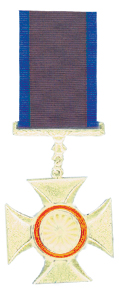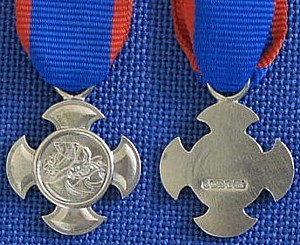The Union of South Africa King's Medal for Bravery, Gold was the highest South African civilian decoration during the period between 1910 and 1961, when the country was a constitutional monarchy in the British Commonwealth. The medal was instituted by King George VI on 23 June 1939.
South African orders, decorations and medals are those military and civilian orders, decorations and medals issued by the Government of South Africa. The following is a (non-exhaustive) list of these:

The Honoris Crux of 1952, post-nominal letters HC, is a military decoration for bravery which was instituted by the Union of South Africa in 1952. It was in use from 1952 to 1975 and was awarded to members of the South African Defence Force for gallantry in action against the enemy in the field. It was discontinued on 1 July 1975, when it was replaced by a new set of four Honoris Crux decorations, in four classes.

The Louw Wepener Decoration, post-nominal letters LWD, is a military decoration for bravery which was instituted by the Union of South Africa in 1952. It was awarded to members of the South African Defence Force for acts of the most conspicuous courage or greatest heroism. The decoration was discontinued on 1 July 1975, when a new set of decorations and medals was instituted.

The Honoris Crux Gold, post-nominal letters HCG, is a South African military decoration for bravery which was instituted in 1975. It was awarded to members of the South African Defence Force for outstanding acts of bravery while in extreme danger. It was the second most senior in a set of four classes of Honoris Crux decorations which replaced the discontinued Honoris Crux of 1952.

The Efficiency Medal (South Africa) was instituted in 1930 for award to part-time warrant officers, non-commissioned officers and men after twelve years of efficient service on the active list of the Citizen Force of the Union of South Africa. At the same time, a clasp was instituted for award to holders of the medal upon completion of further periods of six years of efficient service. The medal superseded the Colonial Auxiliary Forces Long Service Medal.

The Union of South Africa Commemoration Medal is a military and civil commemorative medal which was awarded to commemorate the opening of the first Union Parliament by the Duke of Connaught and Strathearn in 1910. It may be considered as the first of many independence medals which were instituted throughout the Commonwealth during the 20th century.

The Woltemade Decoration for Bravery, Silver is the lesser of two classes of a South African civil decoration for acts of bravery. It replaced the King's Medal for Bravery, Silver and Queen's Medal for Bravery, Silver, the award of which was discontinued in South Africa in 1961.

The Cross for Bravery was instituted by the State President of the Republic of Transkei, for award to all ranks as a decoration for bravery.

The Gallantry Cross, Gold was instituted by the President of the Republic of Venda in 1985, for award to all ranks for extreme courage or supreme bravery or valour beyond the normal call of duty.

The Gallantry Cross, Silver, post-nominal letters GCS, was instituted by the President of the Republic of Venda in 1985, for award to all ranks for courage or bravery or valour beyond the normal call of duty.

The Gold Star for Bravery, post-nominal letters GSB, was instituted by the President of the Republic of South Africa in April 1996. It was awarded to veteran cadres of the Azanian People's Liberation Army, the military wing of the Pan Africanist Congress, who had distinguished themselves during the "struggle" by performing acts of exceptional bravery in great danger.

The Medal for Long Service and Good Conduct (South Africa) (Medalje vir Langdurige Diens en Goeie Gedrag) is a distinctive South African version of the British Medal for Long Service and Good Conduct (Military). It was awarded to members of the Permanent Force of the Union of South Africa who had completed eighteen years of reckonable service.

The Woltemade Decoration for Bravery, Gold is the senior of two classes of a South African civil decoration for acts of bravery. It replaced the Union of South Africa King's Medal for Bravery, Gold and Union of South Africa Queen's Medal for Bravery, Gold, the award of which had been discontinued in 1952 and 1961 respectively.

The Union of South Africa Queen's Medal for Bravery, Gold was the highest South African civilian decoration during the period from 1952 to 1961, while the country was still a constitutional monarchy in the British Commonwealth. The decoration was instituted by Queen Elizabeth II on 15 December 1952.

The Union of South Africa Queen's Medal for Bravery, Silver is the lesser of two classes of a South African civil decoration for acts of bravery that was in use from 1952 to 1961, while the country was still a constitutional monarchy in the British Commonwealth. The decoration was instituted by Queen Elizabeth II on 15 December 1952.

The Woltemade Cross for Bravery, Gold, post-nominal letters WD, is the senior of two classes of a South African civil decoration for acts of bravery. It replaced the Union of South Africa King's Medal for Bravery, Gold, Union of South Africa Queen's Medal for Bravery, Gold and Woltemade Decoration for Bravery, Gold, all of which ranked on par with each other and the award of which had been discontinued in 1952, 1961 and 1988 respectively.

The Woltemade Cross for Bravery, Silver, post-nominal letters WDS, is the lesser of two classes of a South African civil decoration for acts of bravery. It replaced the Union of South Africa King's Medal for Bravery, Silver, Union of South Africa Queen's Medal for Bravery, Silver and Woltemade Decoration for Bravery, Silver, all of which ranked on par with each other and the award of which had been discontinued in 1952, 1961 and 1988 respectively.

In 1895, Queen Victoria authorised Colonial governments to adopt various British military decorations and medals and to award them to their local military forces. The Colony of Natal introduced this system in August 1895 and, in 1897, instituted the Distinguished Conduct Medal (Natal), post-nominal letters DCM.

In May 1895, Queen Victoria authorised Colonial governments to adopt various British military medals and to award them to their local permanent military forces. The Cape of Good Hope and Colony of Natal instituted their own territorial versions of the Meritorious Service Medal in terms of this authority. These two medals remained in use in the respective territories until after the establishment of the Union of South Africa in 1910.

















